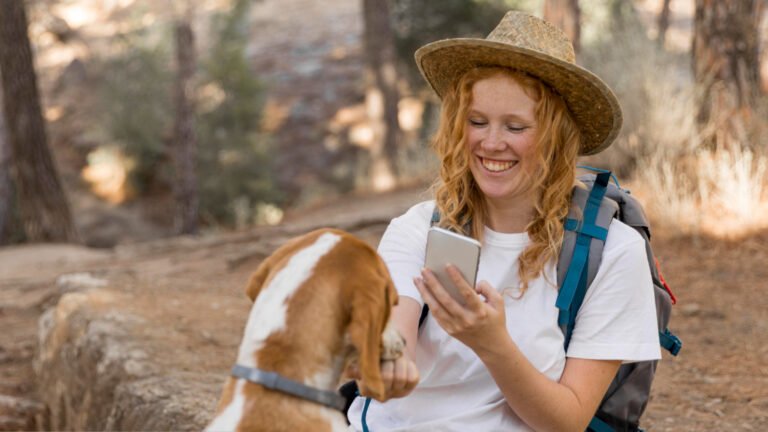Outdoor Adventures with Pets: A Seasonal Safety Guide
The fall season brings a vibrant tapestry of colors and a crisp, cool air that many people adore. It’s a time when families come together, and outdoor adventures become even more inviting. However, as the leaves start to fall and the temperatures drop, there are a few important considerations when it comes to keeping your beloved pets safe and sound. In this article, we will provide a seasonal safety guide for outdoor adventures with pets, including tips for preparing, staying safe, and enjoying activities such as hiking, camping, and water activities. By following these guidelines, you can ensure that your furry friends stay healthy and happy during this beautiful season.
Key Takeaways
- Choose the right gear for your pet, including proper identification and updated vaccinations.
- Train your pet for outdoor activities to ensure their safety and obedience.
- Understand your pet’s limitations and avoid pushing them beyond their physical capabilities.
- Protect your pet from extreme weather conditions, such as cold temperatures and heat.
- Avoid dangerous wildlife encounters by keeping a close eye on your pet and following safety guidelines.
Preparing for Outdoor Adventures with Pets

Choosing the Right Gear for Your Pet
When preparing for outdoor adventures with your pet, it’s important to choose the right gear to ensure their comfort and safety. While some pets have natural fur coats, not all can withstand the cold weather. Short-haired breeds, puppies, and older dogs may be more susceptible to the dropping temperatures. Consider providing them with appropriate clothing or blankets to keep them warm during walks and outdoor playtime. Remember that pets are not immune to frostbite or hypothermia.
Ensuring Your Pet’s Identification and Vaccinations are Up to Date
Microchipping offers an extra layer of protection if your pet ever goes missing. It can facilitate a safe return home if your pet is ever picked up by animal control, shelter personnel, or a well-meaning individual. However, it is not a replacement or substitute for a proper collar and ID tag. If you’ve been wondering what all the fuss is about, we offer a few great reasons to microchip your pet.
Training Your Pet for Outdoor Activities
Training your pet for outdoor activities is essential to ensure their safety and enjoyment. Waterless Dog Shampoo Spray can be a useful tool for keeping your pet clean and fresh during outdoor adventures. This convenient spray allows you to quickly clean your pet’s fur without the need for water, making it perfect for camping trips or hikes where access to water may be limited. Simply spray the shampoo onto your pet’s fur, massage it in, and then towel dry. It’s a great option for removing dirt, mud, and odors from your pet’s coat. Remember to always follow the instructions on the product label and avoid contact with your pet’s eyes or mouth.
Safety Tips for Outdoor Adventures with Pets

Understanding Your Pet’s Limitations
When enjoying outdoor adventures with your pet, it’s important to understand their limitations. Dogs and cats have different physical abilities and may not be able to handle strenuous activities or extreme weather conditions. It’s essential to assess your pet’s fitness level and choose activities that are suitable for them. Additionally, consider their age, breed, and any pre-existing health conditions that may affect their ability to participate in certain activities. Remember to always prioritize your pet’s safety and well-being.
Protecting Your Pet from Extreme Weather Conditions
When it comes to extreme weather conditions, it is important to prioritize the safety and well-being of your pet. While some pets have natural fur coats, not all can withstand the cold weather. Short-haired breeds, puppies, and older dogs may be more susceptible to the dropping temperatures. Consider providing them with appropriate clothing or blankets to keep them warm during walks and outdoor playtime. Remember that pets are not immune to frostbite or hypothermia.
Be Mindful of Seasonal Allergies
Just like people, pets can suffer from allergies. Fall brings its own set of allergens, such as ragweed and mold spores. If you notice your pet scratching excessively, sneezing, or experiencing other allergy symptoms, consult with your veterinarian for appropriate treatment options.
Create a Cozy Retreat
Ensure your furry friend has a warm and comfortable place to retreat after outdoor adventures! Set up a cozy bed in a draft-free area of your home, away from cold windows or floors. Consider placing a blanket or pillow in their favorite spot for comfort and warmth.
While dogs love playing in the snow, being mindful of the time spent outdoors is essential. Limit outdoor activities during freezing weather, and pay attention to signs of discomfort or distress. If your dog starts lifting their paws, shivering, or showing signs of being too cold, it’s time to head back inside and warm up.
Provide Adequate Nutrition and Hydration
During cold weather, pets may require additional energy to stay warm. Consider adding extra food to their bowl to provide the energy needed. Additionally, ensure they have access to fresh water at all times, as hydration is just as crucial in the winter as during the warmer months.
Avoiding Dangerous Wildlife Encounters
When venturing into the great outdoors with your furry companion, it’s important to be aware of the potential dangers that wildlife can pose. Respect wildlife and prohibit your pets from interacting with them or disturbing other visitors. Additionally, make sure you know which areas are open and closed to pets and obey any posted signs. It’s also crucial to never leave your pet unattended or tied to an object, as this can lead to accidents or injuries. Remember, the safety of both your pet and the wildlife around you should always be a top priority.
Hiking and Camping with Pets

Selecting Pet-Friendly Hiking Trails and Campgrounds
When choosing hiking trails and campgrounds to explore with your pet, it’s important to prioritize their safety and comfort. Look for trails and campgrounds that are designated as pet-friendly, as these areas are specifically designed to accommodate pets and their owners. Additionally, consider the terrain and difficulty level of the trails, making sure they are suitable for your pet’s abilities. It’s also a good idea to check if there are any restrictions or regulations regarding pets in the area, such as leash requirements or specific pet-free zones. By selecting the right hiking trails and campgrounds, you can ensure a positive and enjoyable outdoor experience for both you and your furry companion.
Packing Essential Items for Your Pet’s Comfort
When preparing for outdoor adventures with your pet, it’s important to pack essential items that will ensure their comfort throughout the trip. Here are some key items to include:
-
Food and Water: Make sure to bring enough food for your pet’s entire stay, as well as a portable water bowl and plenty of fresh water. Hydration is crucial for your pet’s well-being, especially during physical activities.
-
Bedding and Blankets: Providing a comfortable place for your pet to rest is essential. Pack their favorite blanket or bed to make them feel at home.
-
Leash and Collar: Keep your pet safe and secure by bringing a sturdy leash and a properly fitted collar with identification tags. This will help prevent them from getting lost and ensure their safety.
-
Toys and Treats: Keep your pet entertained and rewarded with their favorite toys and treats. These can help alleviate boredom and provide mental stimulation during downtime.
Remember, packing these essential items will help make your pet’s outdoor adventure enjoyable and stress-free.
Setting Up a Safe Campsite for Your Pet
When setting up a safe campsite for your pet, there are a few important considerations to keep in mind. First, choose a designated area for your pet’s sleeping and resting space. This will help establish boundaries and ensure that your pet feels secure in their own space. Next, remove any potential hazards from the campsite, such as sharp objects, toxic plants, or open flames. It’s also a good idea to secure your pet’s leash or harness to a sturdy object to prevent them from wandering off. Additionally, provide shade and fresh water for your pet to stay hydrated and comfortable throughout the day. Finally, keep a close eye on your pet and be aware of their behavior. If they show signs of distress or discomfort, it’s important to address their needs and make any necessary adjustments to the campsite setup.
Water Activities with Pets

Choosing the Right Life Jacket for Your Pet
When participating in water activities with your pet, it’s important to prioritize their safety. Choosing the right life jacket is crucial to ensure that your furry friend stays afloat and protected. Here are some factors to consider when selecting a life jacket for your pet:
- Size: Make sure to choose a life jacket that fits your pet properly. It should be snug but not too tight, allowing them to move comfortably.
- Buoyancy: Look for a life jacket with sufficient buoyancy to keep your pet afloat. It should have flotation panels strategically placed to support their body in the water.
- Visibility: Opt for a life jacket that is brightly colored or has reflective strips. This will make it easier to spot your pet in the water, especially in low-light conditions.
Remember, even if your pet is a strong swimmer, unexpected situations can occur. Having them wear a life jacket provides an extra layer of protection and peace of mind. Enjoy your water adventures with your furry companion!
Teaching Your Pet to Swim Safely
When teaching your pet to swim, it’s important to take certain precautions to ensure their safety in the water. Introduce them to water gradually and provide them with a properly fitted life jacket to keep them afloat. Start in shallow water and encourage them with positive reinforcement. Never force your pet into the water if they are hesitant or scared. Stay close and supervise them at all times to prevent accidents. Additionally, avoid swimming in areas with strong currents or rough waves as it can be dangerous for both you and your pet. Remember, swimming can be a fun and enjoyable activity for your pet, but it’s essential to prioritize their safety.
Monitoring Your Pet’s Water Intake
When engaging in water activities with your pet, it is important to monitor their water intake to ensure they stay hydrated. Cats have unique hydration needs, and it is essential to provide them with fresh water at all times. While some cats may prefer running water, others may be content with a regular water bowl. Keep an eye on their water consumption and refill their bowl as needed. If you notice any changes in their drinking habits, it is important to consult with your veterinarian. Additionally, be cautious of any potential hazards in the water, such as strong currents or harmful algae blooms. Always prioritize your pet’s safety and well-being when enjoying water activities together.
Water activities with pets are a great way to bond and have fun together. Whether you have a dog or a cat, there are plenty of water-based activities that can keep them entertained and active. From swimming in the pool to playing fetch at the beach, these activities provide both physical exercise and mental stimulation for your furry friend. At Whisker Wellbeing, we understand the importance of holistic and natural care for pets. That’s why we offer a variety of products, including CBD, hemp, and other natural options, all designed to enhance the physical and emotional quality of life of pets. Visit our website to explore our range of products and discover how you can improve your pet’s well-being today!
Conclusion
As the fall season arrives, it’s time to enjoy the great outdoors with your pets. However, it’s important to be aware of the unique challenges and risks that come with this beautiful season. By following these pet safety tips for fall, you can ensure that your four-legged family members stay healthy and happy. Remember to stay vigilant, be prepared, and make responsible choices to keep your pets safe and sound throughout autumn. With these precautions in mind, you and your furry friends can have a season filled with fun adventures and memorable moments. Happy exploring!
Frequently Asked Questions
What gear should I bring for my pet on outdoor adventures?
When going on outdoor adventures with your pet, it’s important to bring the right gear to ensure their safety and comfort. Some essential items to pack include a leash, collar with identification tags, water and food bowls, a pet first aid kit, poop bags, and any necessary medications. Additionally, depending on the activity and weather conditions, you may need to bring items such as a life jacket, hiking boots for dogs, a cooling vest, or a pet tent.
How can I ensure my pet’s identification and vaccinations are up to date?
Before embarking on outdoor adventures with your pet, make sure their identification and vaccinations are up to date. Ensure that your pet is wearing a collar with current identification tags, including your contact information. It’s also a good idea to have your pet microchipped as an additional form of identification. Schedule a visit to your veterinarian to ensure your pet is up to date on vaccinations, including rabies, and consider getting a flea and tick preventative treatment if necessary.
How can I train my pet for outdoor activities?
Training your pet for outdoor activities is important to ensure their safety and enjoyment. Start by teaching basic obedience commands such as sit, stay, and come. Practice these commands in different outdoor environments to help your pet generalize the training. Gradually introduce your pet to new outdoor experiences, such as walking on different surfaces or encountering other animals. Use positive reinforcement techniques, such as treats and praise, to reward your pet for good behavior. Consider enrolling in a training class or working with a professional trainer if you need additional guidance.
What are the limitations I should be aware of when taking my pet outdoors?
When taking your pet outdoors, it’s important to be aware of their limitations. Consider your pet’s age, breed, health condition, and fitness level when planning outdoor activities. Some pets may have physical limitations that prevent them from participating in certain activities, while others may have sensitivities to extreme temperatures or certain terrains. Pay attention to your pet’s behavior and energy level during outdoor adventures, and be prepared to modify or end the activity if necessary.
How can I protect my pet from extreme weather conditions?
Extreme weather conditions can pose risks to your pet’s health and safety. In hot weather, provide plenty of shade and fresh water, and avoid exercising your pet during the hottest parts of the day. Consider using a cooling vest or wetting your pet’s fur to help them stay cool. In cold weather, provide your pet with a warm shelter, such as a insulated dog house or a cozy blanket indoors. Dress your pet in a sweater or jacket to help them retain body heat, and consider using booties to protect their paws from ice and salt on the ground.
How can I avoid dangerous wildlife encounters with my pet?
When venturing into areas with wildlife, it’s important to take precautions to avoid dangerous encounters for both you and your pet. Keep your pet on a leash at all times to prevent them from chasing or approaching wildlife. Stay on designated trails and avoid areas known to have a high concentration of wildlife. Make noise while hiking or walking to alert wildlife of your presence and give them a chance to move away. If you encounter wildlife, do not approach or feed them, and slowly back away while keeping your pet close to you.






